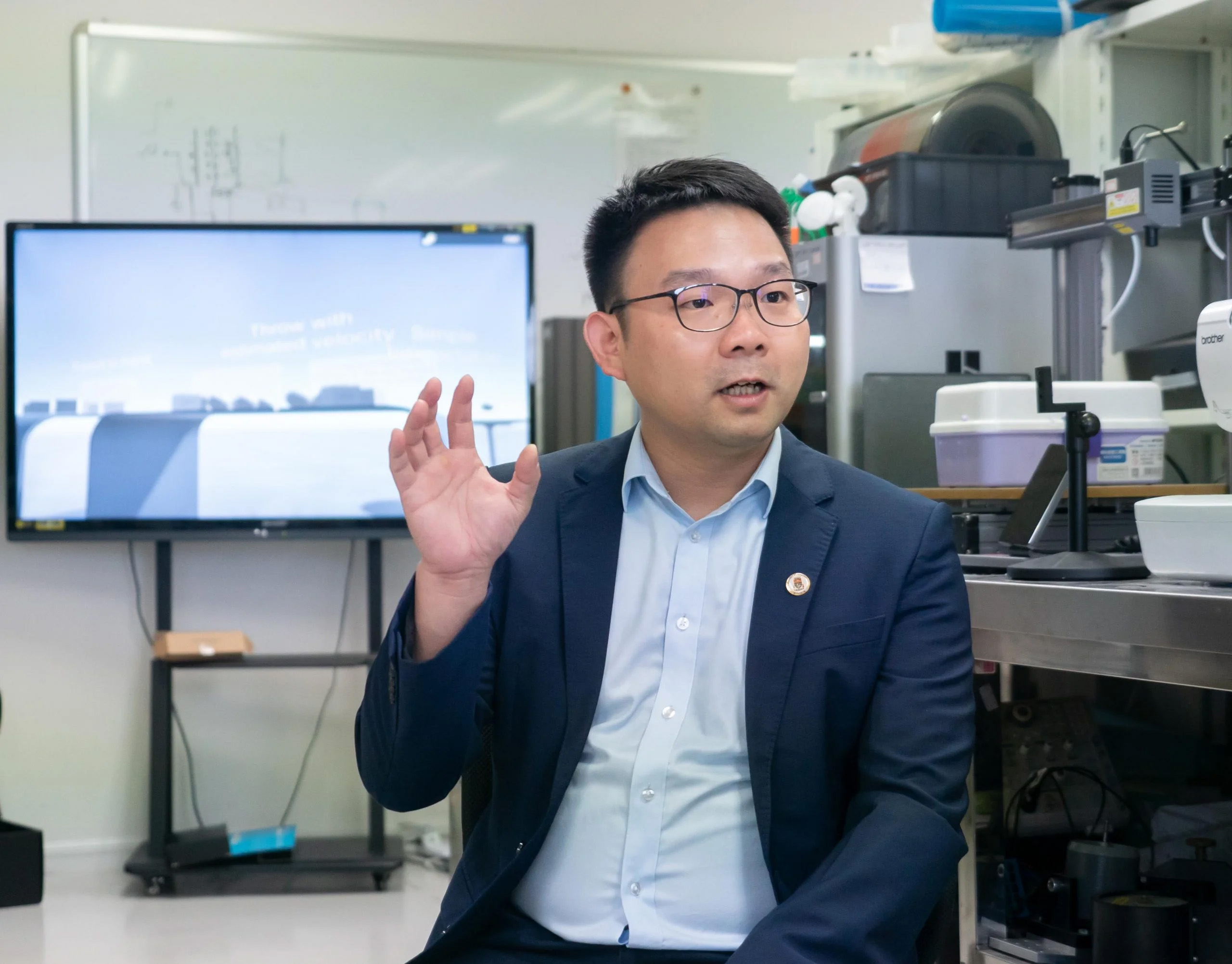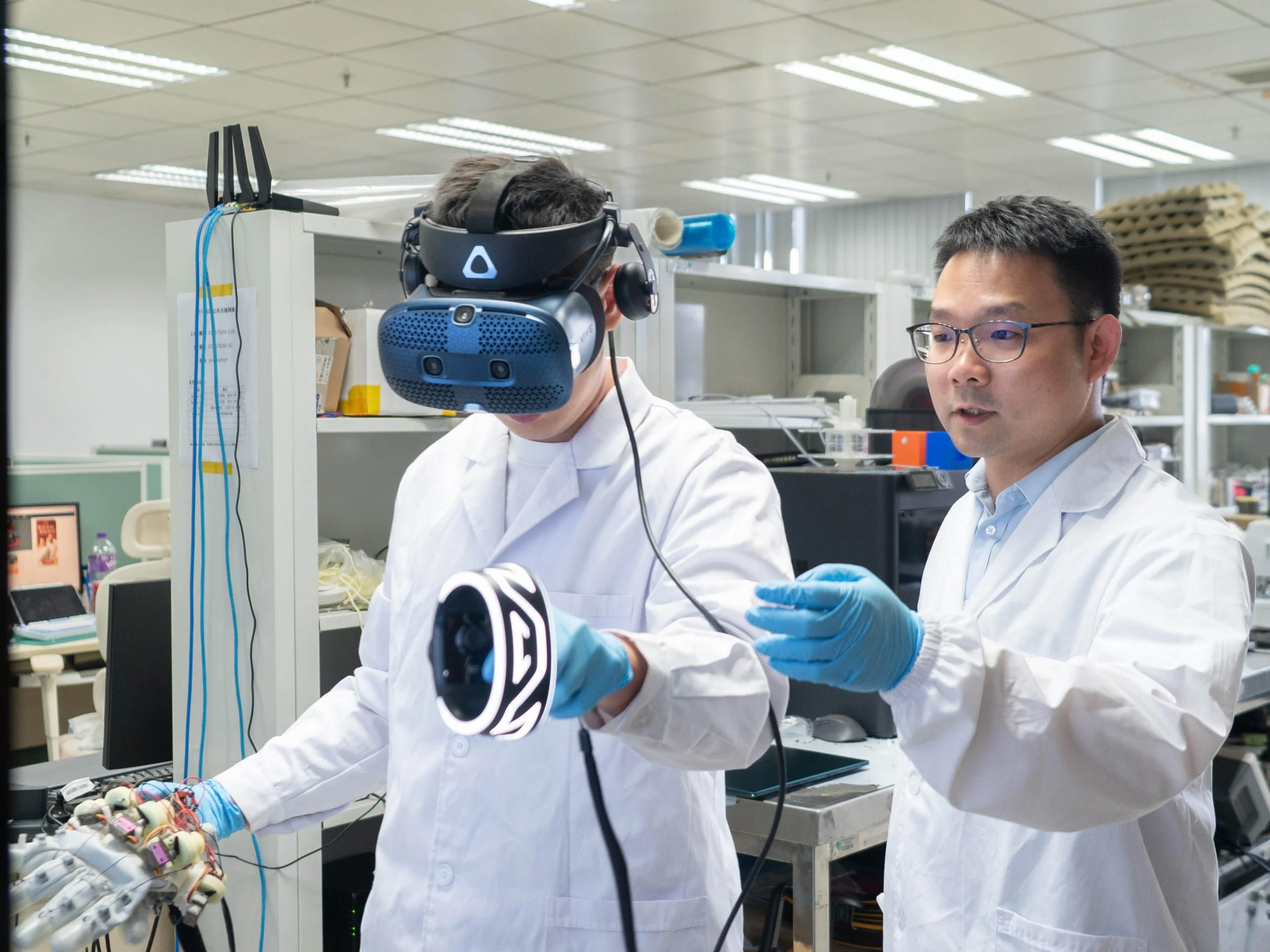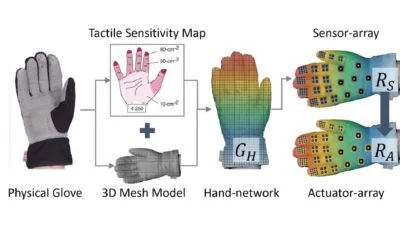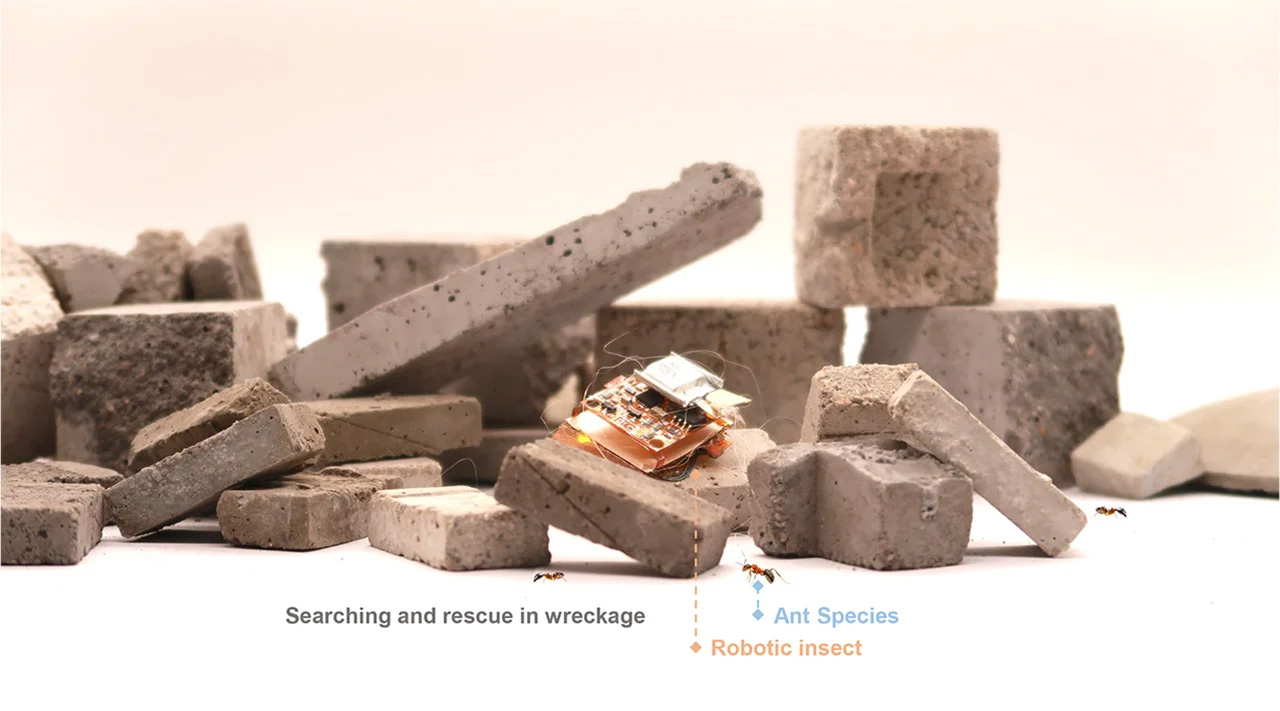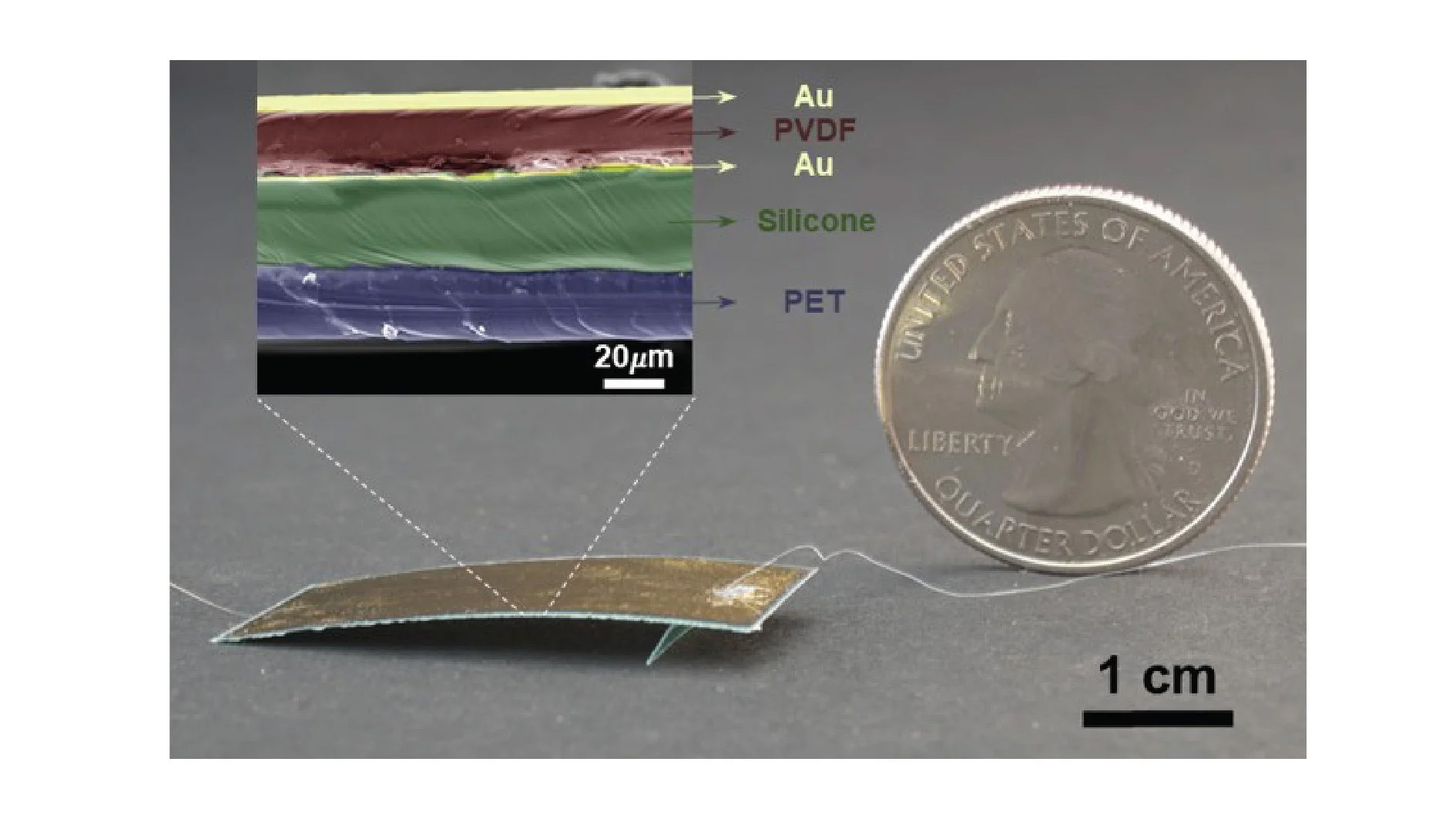A three-centimetre-long electronic insect scuttles across a dark, maze-like disaster simulation area, carrying out instructions to aid in rescue operations with flexible and agile movements. This is a demonstration conducted by Zhong Junwen, assistant professor in the Department of Electromechanical Engineering in the Faculty of Science and Technology at the University of Macau (UM) and a member of the UM Centre for Artificial Intelligence and Robotics. The electronic insect is one of the flexible robots developed by Prof Zhong in the Soft Sensors-Actuators-Robots Laboratory at UM. Currently, this young up-and-coming scholar is advancing research in flexible smart materials, aiming to equip robots with the ability to transmit tactile sensations.
Bringing childhood fantasies to life
Like many children, Prof Zhong had many whimsical fantasies when he was a boy. One of his dreams was to hug a lion at the zoo and stroke its mane to feel the soft fur of the majestic animal. Now, in his early thirties, Prof Zhong is bringing these childhood fantasies to life through groundbreaking research. He is collaborating with Chimelong Group to develop an innovative smart glove. This glove, when paired with VR glasses, provides users with an immersive experience, allowing them to feel the texture of various animal furs and observe the animals’ reactions to human touch.
Indeed, this smart glove was not developed from scratch. During the COVID-19 pandemic, Prof Zhong and his doctoral students developed a flexible smart material for use in smart clothing. This innovative fabric is capable of transmitting tactile sensations, allowing people who are physically distant to feel each other’s touch and simulate hugs when wearing the garments. Building on this technology, the material’s functionality has been expanded and adapted for the smart glove, enabling users to experience virtual sensation of real objects.
‘Flexible’ is a keyword in Prof Zhong’s research. Unlike their rigid counterparts, flexible materials are characterised by their ultra-softness, low modulus, and high deformability, which make them ideal for capturing motion perception and tactile feedback. Prof Zhong emphasises the significance of advancing human-computer interaction technology through the research and development of flexible smart materials. These materials not only enable children to explore the world more effectively, but also have extensive applications in home care, disaster detection, and other critical scenarios, where they play a crucial role in enhancing safety and improving outcomes.
Giving robots a sense of touch
As an emerging young scholar, Prof Zhong understands both the significance and challenges of AI research in the contemporary era. He explains, ‘In the field of human-computer interaction, replicating tactile sensations presents significant challenges. Given the extremely complex human perception system, creating a similar system in robots is no easy task.’
Since joining UM in 2020, Prof Zhong has established the Soft Sensors-Actuators-Robots Laboratory. Through this laboratory, he has led his research team in tackling challenges in the design of flexible smart technologies. His goal is to equip robots with sensory capabilities similar to those of human skin, thereby enabling a robotic ‘sense of touch’. In addition, he aims to foster greater interdisciplinary integration of AI research.
Currently, Prof Zhong’s team is developing smart clothing that can monitor the health status of elderly individuals and transmit health signals in real time. He explains, ‘In the event of an accident, this smart clothing can detect the dangerous condition of the elderly individual and upload the health data to the cloud immediately. This allows medical staff to be alerted immediately and respond promptly.’
Prof Zhong also highlights the crucial role of human-computer technology in managing emergency tasks during disaster scenarios. His team is developing a haptic simulation system for nuclear accident scenarios. He explains, ‘Imagine a nuclear accident occurs, and a robot is sent to the site. It must accurately locate and press the emergency switch to close the valve and stop the nuclear leakage. If human operators only monitor the situation on a screen, they may not be able to verify that the robot has executed the command correctly. However, the human-computer interaction system we are developing allows operators to experience the tactile sensation of pressing the valve, which will significantly increase the accuracy of performing such critical tasks in real situations.’
Venturing into a niche field
Human-computer interaction is now a popular research topic. Reflecting on how he started his journey into ‘flexible electromechanical technology’, Prof Zhong humorously notes that he chose a niche field involving few researchers. He recalls that sensors were traditionally made from rigid materials and were both large and heavy. A significant turning point occurred when he observed rescue teams using small robots for detection, search, and rescue operations during the Wenchuan earthquake in 2008. At that time, the technology was still underdeveloped and received little attention from the scientific community. However, Prof Zhong recognised that flexible electromechanical systems would become crucial technologies for the development of future intelligent robots. He believed that the less mature a technology is, the more worthwhile it is to explore, as it holds significant breakthrough potential.
Later, while working as a postdoctoral researcher in California, US, Prof Zhong developed new ideas for disaster relief robots. Living in an area heavily infested with American cockroaches, he struggled to control them despite setting numerous traps in his dormitory. The cockroaches consistently managed to escape, frustrating Prof Zhong but also sparking his curiosity about the potential advantages of their resilience and agility. He started to wonder if the flexible bodies and agile movements of insects could be replicated into the design of flexible robots. Inspired by this experience, Prof Zhong and his team initiated a research project that spanned several years. In 2012, they successfully developed a novel electronic insect at UM.
Standing just three centimetres tall and characterised by its high agility and controllability, this electronic insect was capable of recording and transmitting valuable information during search and rescue operations. Moreover, it outperformed existing flexible robots at the time—it was able to navigate a 1.2-metre-long maze in 5.6 seconds and carry a 180 mg gas sensor to detect gas leaks. This groundbreaking research was later published in the prestigious international journal Science Robotics.
With his dedication to research in flexible electromechanical systems, Prof Zhong has made significant achievements. He has published more than 50 academic papers in international journals in recent years, accumulating 8,500 citation counts in total. He highlights that UM professors in the field of science and technology come from diverse backgrounds and have distinct and innovative research interests, fostering an environment conducive to interdisciplinary development. Prof Zhong believes that through the collaborative efforts of faculty and students, artificial intelligence and robotics will become signature UM disciplines.
Using the laboratory as a training ground
UM’s Soft Sensors-Actuators-Robots Laboratory is always bustling with undergraduate students who immerse themselves in research and enjoy discussing with Prof Zhong the challenges they encounter during experiments. Under Prof Zhong’s guidance, these students participate in research projects and gain hands-on experience with the entire experimental process. Interestingly, many of these students do not have backgrounds in mechanical or electrical engineering. Prof Zhong explains that involving students from various disciplines in research promotes interdisciplinary development and enhances the potential for new discoveries.
Prof Zhong continues, ‘In my laboratory, I encourage discussions among students from different disciplines, as this can spark innovative ideas and inspire new research directions. Without such interactions, the laboratory would become stagnant. I have only one requirement for students who come to the laboratory: they must possess a solid understanding of the basics of physics and chemistry. With this strong foundation, they can tackle any challenge that comes their way.’ This requirement, while it may seem unusual, is related to Prof Zhong’s educational background. Prof Zhong initially studied chemistry as an undergraduate before discovering his research passion and shifting to electrical science and engineering for his PhD. Reflecting on this journey, Prof Zhong expresses gratitude for his determination to overcome challenges. His perseverance solidified his foundation in chemistry and deepened his understanding of chemical materials and devices. This background later proved to be invaluable as he ventured into the development of flexible circuit systems.
Prof Zhong believes that a solid foundation is essential for achieving greater success, so he emphasises the importance of mastering fundamental knowledge. Over the years, his laboratory has served as a training ground for students. Undergraduates who have undergone laboratory training often receive better offers for further studies after graduation, thanks to their robust knowledge base and strong interdisciplinary thinking. Prof Zhong shares one notable example, an undergraduate student who had a keen interest in aquatic insects. In his second year, this student collaborated with a doctoral student to develop an aquatic insect robot, which achieved impressive results in practical applications.
Prof Zhong continues, ‘This student gained substantial fundamental knowledge and research experience in my laboratory. I wrote him a letter of recommendation for a master’s degree programme at my alma mater, the University of California, Berkeley. He not only completed his master’s there, but is now pursuing a PhD at Purdue University.’
The ultimate goal: publishing a seminal book
As the saying goes, ‘If you are not moving forward, you are falling behind.’ Prof Zhong believes that in today’s rapidly evolving digital era, particularly with the advancements of AI technology, it is crucial for researchers to enhance their knowledge and skills while maintaining a humble and curious attitude. Therefore, he often reminds students that even after they have developed new technology, they must continue learning and stay abreast of the latest AI robotics trends. He notes, ‘In academia, you cannot rest on your laurels and expect to sustain a career.’ With this perspective, Prof Zhong is committed to acquiring new knowledge and exploring new discoveries. His ultimate goal is to write a book that encapsulates his research findings. The young scholar shares his ultimate dream: ‘I hope to publish a seminal book that becomes a key reference in the field. Seeing my book on shelves in bookstores around the world is my most ambitious goal.’
Source: My UM Issue 139
一款身長僅3厘米的電子昆蟲,穿梭於漆黑一片、仿如迷宮的模擬災難現場,執行多項協助救援的指令,動作靈活敏捷,而背後的示範操作者,正是年輕有為的鍾俊文教授。他是澳大科技學院機電工程系助理教授、人工智能機器人研究中心成員。電子昆蟲是其開發的其中一款柔性機器人,是依託大學「柔性傳感器—執行器—機器人實驗室」資源的科研成果。目前,鍾教授正積極推進柔性智能材料的研究,致力賦予智能機器人隔空「摸」物的能力。
盼圓童年夢
小時候的鍾俊文教授,與身邊的小孩一樣有許多獨特新奇的想法,其中一個是擁抱動物園裡的獅子王,撫摸「獸王」脖子上濃密的鬃毛,感受那毛茸茸的觸感。三十出頭的他憑藉出色的研究,終有機會令他兒時的夢想成真。鍾教授正與長隆集團合作,研發一款嶄新的智能手套。當用家配戴上這款手套及VR眼鏡,就能沉浸式感受不同動物的皮毛質感,以及體驗動物被觸碰時的反應。
研發智能手套的工作並非由零開始。早在疫情期間,鍾教授與其博士生成功研發出一種智能柔性物料,可製作成傳遞觸覺的智能衣服,讓縱然相隔千里的二人能透過衣服感受到對方的觸摸和擁抱。如今這一物料的特性再度被應用於智能手套上,讓用家隔空「摸」物。
「柔性」是鍾俊文教授研究的關鍵字,與剛性材料的概念相對,具超柔軟、低模量、易變形等屬性,亦是捕捉運動感知與觸覺回饋的關鍵。鍾教授指出,透過智能柔性物料研發來推進人機交互技術深具意義,除了可幫助小朋友探索世界,還能廣泛應用在家居護理、災難探測等場景,在千鈞一髮中發揮重要作用。
喚起機器人的「觸覺」
鍾俊文教授是新生代的年輕學者,在如今AI盛行的世代,他深明人工智能研究的重要意義,更深知這條學術之路並非易行。「在人機交互的科學上,模仿觸覺卻是一大挑戰,因為人類的感知系統相當複雜,要在機器人身上構建類似的感知系統實屬不易。」鍾俊文直率而真誠地表示。
鍾教授自2020年加入澳大後,全力搭建「柔性傳感器—執行器—機器人實驗室」,並依託實驗室的力量,引領團隊攻關多項柔性智能技術,致力賦予機器人有如「皮膚」的感知能力,從而喚起其「觸覺」,為人工智能前沿研究以及學科交叉融合注入新動力。
鍾教授團隊正積極開發一款能實時監測並傳遞長者健康訊號的智能衣物,「當發生意外,這款智能衣服能感知到長者的危險狀態,並把相關身體數據即時上傳到雲端,即時通知醫務人員以作出及時回應。」
鍾教授還透露,人機交互技術更能協助人們在災難場景執行緊急任務,而當前實驗室正研發一套具觸感的模擬核事故系統。「假設有核事故發生,被派往現場的機器人須精準定位並按下關閉核洩漏閥門的緊急掣,但人類操控員若僅從屏幕監測,無法確認機器人是否如實執行指令。這套人機交互系統,能讓操作員感受到按下閥門時的感覺,大大增加實際執行任務時的準確性。」
走小眾的研究之路
人機交互如今是炙手可熱的研究課題,但回想最初投身「柔性機電技術」科研之路,鍾俊文教授笑言,自己是向「小眾研究路」走去。他憶述,舊式的傳感器以剛性物料為主,體積大且笨重,直至2008年的汶川大地震,他目睹有人利用小型機器人進行探測及搜救工作,但當年的技術和性能並不成熟,畢竟相關技術仍處於初始階段,尚未被科學界重點關注。鍾教授逐漸意識到,柔性機電系統將是未來智能機器人的關鍵技術之一,而且越不成熟的東西,越值得研究,越有希望取得突破。
後來他在美國加州當博士後研究員時,對救災機器人產生了新的想法。當地美洲蟑螂泛濫,他雖在宿舍設下天羅地網,這些蟑螂還是有辦法死裡逃生。在懊惱的同時,他思考著若把這軀幹柔韌、爬行敏捷的昆蟲特性,用於設計柔性機器人會怎樣?受此啟發,鍾俊文與團隊開展長達數年的研究,並最終在2021年於澳大成功研製出一款嶄新的電子昆蟲。
這款身長僅有3厘米的電子昆蟲,具高敏捷性與可操控性,能於搜索和救援過程中,記錄及傳輸有價值的訊息。它的性能優於當時已知的柔性機器人,僅需5.6秒便能快速越過1.2米長的迷宮,其身上攜帶180 mg的氣體傳感器,用於探測氣體洩漏。有關這項研究的文章,後來獲國際頂級期刊《Science Robotics》刊登。
鍾俊文教授一直潛心於柔性機電系統的研究,並取得卓越的進展。近年於國際期刊發表學術論文逾50篇,總引用超過8500次。他認為,澳大科技領域的教授背景多元,有多個獨特且前沿的研究方向,為學科交叉創設條件。他相信在師生的共同努力下,人工智能與機器人將成澳大的特色學科。
勇闖「木人巷」
在「柔性傳感器—執行器—機器人實驗室」裡,經常見到本科學生埋首研究的身影,並不時與鍾教授探討在實驗過程中遇到的問題。他們在鍾教授的指導下參與了大學的科研項目,熟悉實驗操作的整個流程。有趣的是,這些本科生大多不具備機電工程的背景,鍾教授認為,讓不同領域的學生參與研究,有助於推動學科交叉發展,為發現新知識增添可能。
鍾教授進一步詮釋想法:「在實驗室裡,我歡迎不同學科的學生參與討論,激發起思維碰撞的火花,帶來新的研究構思,不然會變成一潭死水。我對來這裡的學生只有一個要求,就是有紮實的物理、化學基礎知識,其他就不成問題了。」鍾教授這個看似奇怪的要求,與他自身的求學經歷不無關係。他本科攻讀化學專業,後釐清研究志向,到博士階段挑戰電氣科學與工程。回顧來時路,鍾教授慶幸求學時不畏艱苦,打下扎實的化學根基,熟悉化學材料及器件,對後來開發柔性電路系統甚有助益。
對鍾教授來說,有穩扎的根基才能站得更高走得更遠,因此他常勉勵學生學好基礎知識。這些年來,他的實驗室猶如一條「木人巷」,能從裡面走出來的本科學生,因為知識基礎牢固、善於跨學科思考,畢業後大都得到較好的深造機會。他指導的其中一位學生,因為對水上生活的昆蟲特別感興趣,大二時便開始與博士生合作,共同研發出一款水上昆蟲機器人,收到不錯的應用效果。
他說:「這位學生在我的實驗室積累了大量的基礎知識和科研經驗,本科畢業時,我為他寫了一封推薦信,支持他到我的母校——美國加州大學伯克利分校攻讀碩士研究生,如今他正在普渡大學讀博。」
「上書架」的心願
人之為學,不日進則日退。在如今數字時代,AI科技日新月異,鍾俊文教授認為,年輕的研究員更須時刻鞭策自己,永遠保持一顆謙卑的心、一份求知的熱情。他經常提醒學生,即使開發了一項新技術,仍需要不斷學習,掌握AI機器人領域最新的發展趨勢,「僅靠一次的成功,就能坐吃一輩子,在科研界是天荒夜談。」相反地,鍾教授正不斷地累積新知識,樂此不疲地研究新發現,期待終有一天能把所學所得著成一書,實現「上書架」的終極夢,為浩瀚的知識海洋留下滄海一粟。「每當提起這一研究領域,大家就可在書架上翻閱到我的著作!」這正是三十而立的鍾俊文內心所堅持所渴望實現的夢想。
來源:《澳大人》第139期


